The Intel Comet Lake Core i9-10900K, i7-10700K, i5-10600K CPU Review: Skylake We Go Again
by Dr. Ian Cutress on May 20, 2020 9:00 AM EST- Posted in
- CPUs
- Intel
- Skylake
- 14nm
- Z490
- 10th Gen Core
- Comet Lake
Our Office and Science Test section focuses significantly on real-world testing, user experience, with a slight nod to throughput. In this section we cover application loading time, image processing, simple scientific physics, artificial intelligence, and AVX accelerated code.
All of our benchmark results can also be found in our benchmark engine, Bench.
Office Tests
Application Load: GIMP 2.10.4
One of the most important aspects about user experience and workflow is how fast does a system respond. A good test of this is to see how long it takes for an application to load. Most applications these days, when on an SSD, load fairly instantly, however some office tools require asset pre-loading before being available. Most operating systems employ caching as well, so when certain software is loaded repeatedly (web browser, office tools), then can be initialized much quicker.
In our last suite, we tested how long it took to load a large PDF in Adobe Acrobat. Unfortunately this test was a nightmare to program for, and didn’t transfer over to Win10 RS3 easily. In the meantime we discovered an application that can automate this test, and we put it up against GIMP, a popular free open-source online photo editing tool, and the major alternative to Adobe Photoshop. We set it to load a large 50MB design template, and perform the load 10 times with 10 seconds in-between each. Due to caching, the first 3-5 results are often slower than the rest, and time to cache can be inconsistent, we take the average of the last five results to show CPU processing on cached loading.
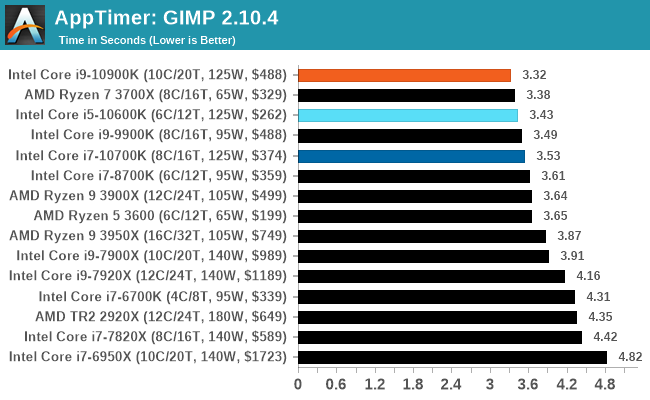
GIMP likes fast single core performance, and so the Core i9 wins here.
Agisoft Photoscan 1.3.3: 2D Image to 3D Model Conversion
One of the ISVs that we have worked with for a number of years is Agisoft, who develop software called PhotoScan that transforms a number of 2D images into a 3D model. This is an important tool in model development and archiving, and relies on a number of single threaded and multi-threaded algorithms to go from one side of the computation to the other.
In our test, we take v1.3.3 of the software with a good sized data set of 84 x 18 megapixel photos and push it through a reasonably fast variant of the algorithms, but is still more stringent than our 2017 test. We report the total time to complete the process.
Agisoft’s Photoscan website can be found here: http://www.agisoft.com/
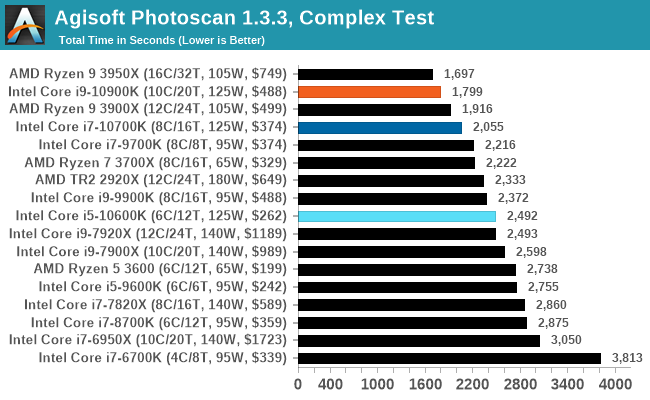
Agisoft is a mix of variable threaded workloads, so a good balanced system works best. Intel's $500 option is faster than AMD's $500 option here, with two fewer cores.
AI Benchmark
One of the longest time requests we’ve had for our benchmark suite is AI-related benchmark, and the folks over at ETH have moved their popular AI Benchmark from mobile over PC. Using Intel’s MKL and Tensorflow 2.1.0, we use version 0.1.2 of the benchmark which tests both training and inference over a variety of different models. You can read the full scope of the benchmark here.
This is one of our new tests in the database, and we are still gaining data for it.
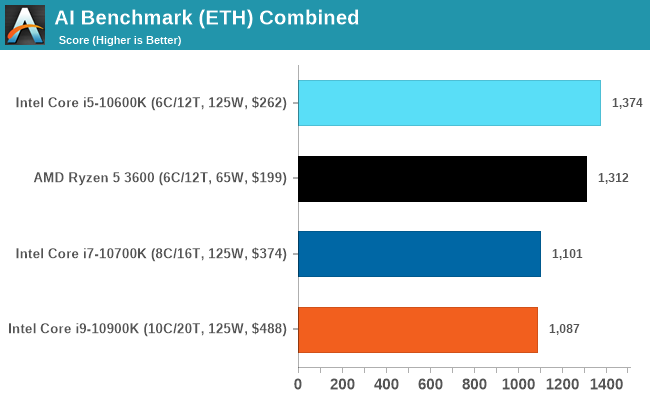
AIBench is a new test here, covering both training and inference. In the breakdown of results, we noticed that the faster processors were actually slower, scoring a lower result. We believe this is down to the lower bandwidth/core afforded by the 10c design against the 6c design.
Accelerated Science Tests
3D Particle Movement v2.1: Brownian Motion
Our 3DPM test is a custom built benchmark designed to simulate six different particle movement algorithms of points in a 3D space. The algorithms were developed as part of my PhD., and while ultimately perform best on a GPU, provide a good idea on how instruction streams are interpreted by different microarchitectures.
A key part of the algorithms is the random number generation – we use relatively fast generation which ends up implementing dependency chains in the code. The upgrade over the naïve first version of this code solved for false sharing in the caches, a major bottleneck. We are also looking at AVX2 and AVX512 versions of this benchmark for future reviews.
For this test, we run a stock particle set over the six algorithms for 20 seconds apiece, with 10 second pauses, and report the total rate of particle movement, in millions of operations (movements) per second. We have a non-AVX version and an AVX version, with the latter implementing AVX512 and AVX2 where possible.
3DPM v2.1 can be downloaded from our server: 3DPMv2.1.rar (13.0 MB)


No real surprises in our 3DPM tests.
y-Cruncher v0.7.6: Microarchitecture Optimized Compute
I’ve known about y-Cruncher for a while, as a tool to help compute various mathematical constants, but it wasn’t until I began talking with its developer, Alex Yee, a researcher from NWU and now software optimization developer, that I realized that he has optimized the software like crazy to get the best performance. Naturally, any simulation that can take 20+ days can benefit from a 1% performance increase! Alex started y-cruncher as a high-school project, but it is now at a state where Alex is keeping it up to date to take advantage of the latest instruction sets before they are even made available in hardware.
For our test we run y-cruncher v0.7.6 through all the different optimized variants of the binary, single threaded and multi-threaded, including the AVX-512 optimized binaries. The test is to calculate 250m digits of Pi, and we use the single threaded and multi-threaded versions of this test.
Users can download y-cruncher from Alex’s website: http://www.numberworld.org/y-cruncher/
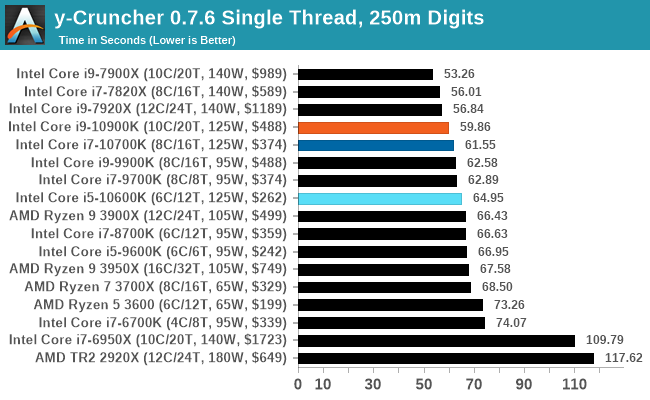
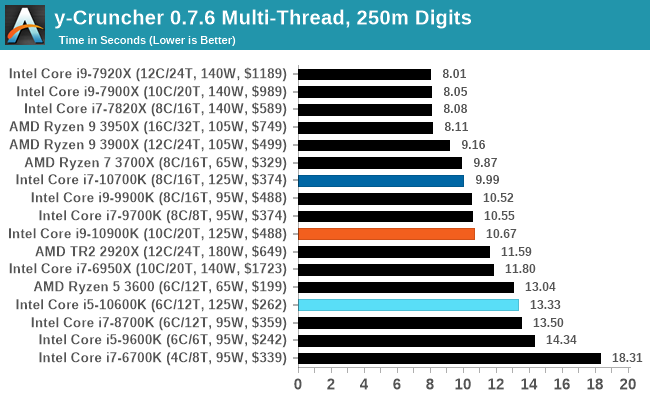
y-Cruncher is another one where the Core i9 performs worse than the Core i7 in the multithreaded test, despite being better on the single threaded test. We again put this down to memory bandwidth. We need to update this test to the latest version of y-Cruncher, which has additional optimizations for Zen 2 processors, but also to increase the digit count in our MT test.











220 Comments
View All Comments
Spunjji - Tuesday, May 26, 2020 - link
Mixed disagree.In all likelihood, Intel is incentivizing OEMs to continue working with their products.
It certainly looks like there is some sort of unspecified agreement between OEMs, Intel and Nvidia - hence the seemingly universal limitation of the 2060 with an AMD CPU.
But then... this absolutely is AMD's first proper crack at a high-end notebook chip that performs up to its billing in a very, very long time. It will take time for it to filter though, so the current state of the market may not be a good indicator - especially with COVID-19 about.
Tunnah - Wednesday, May 20, 2020 - link
Regarding your gaming suite test and GTA V/Steam limitations; why not switch to the cracked, offline version ? It's not like you're pirating it as you already bought it.Also you could keep a monolithic version in which you could insert any scripts you want via the modding capabilities, and because it's offline, updates won't come in and screw up your files. I keep a pirate version separate for messing around with modding on, and I never have to worry about an update rolling things back.
arashi - Sunday, May 24, 2020 - link
I'm sure the legal liability would be very welcome.Hxx - Wednesday, May 20, 2020 - link
im excited for the 10700k for my gaming rig. almost as good as the 10900k but cheaper and less power hungry.HammerStrike - Wednesday, May 20, 2020 - link
The lack of PCIe 4.0 is a deal breaker for any gaming focused box. The one area where the new consoles have an undisputed lead is in their SSD’s and I/O infrastructure. As game engines and game design are transformed by this I think, within a few years, we are going to see game performance improvements with faster SSD’s. Much more so then the few % Intel currently has,based on CPU alone. Which is only really of practical benefit if you have a monitor with 165+ refresh rate and game at those settings. I love a high refresh but I’d much rather have the pretty bells and whistles on and get 80-120hz vs setting everything to low for 165.AMD chips are just much more compelling. Of course, unless you absolutely have to upgrade now, I’d wait a few months for Zen 3. Fair chance they take the performance crown, or get so close as not to matter. Plus they will run a lot cooler - even if you don’t care about the power draw per say, the cooler a chip runs the cheaper / quieter the cooling solution is. Take that savings and put it in a GPU, RAM or PCIe 4.0 SSD.
Boshum - Wednesday, May 20, 2020 - link
I don't think lack of PCIe 4.0 is that bad, but is it certain that the LGA1200 won't support PCIe 4.0 when a Rocket Lake chip is plugged in?WaWaThreeFIVbroS - Thursday, May 21, 2020 - link
The board may support PCIe 4.0 signals but the Z490 chipset doesn't, so when a rocket lake is plugged in the PCIe 4 will probably only came from the CPUImNotARobot - Wednesday, May 20, 2020 - link
I feel like there is a lack of testing between PCIe 4 and 3. The way I look at it, nvidia is right around the corner from launch their PCIe 4 lineup so these processors are going to be powering that. I haven't seen anyone review an AMD 5700xt on an intel and AMD machine just to see what other real life gaming impact that can have. Agreed if you're a hardcore gamer you might not want a 5700xt...but it gives insight on what next gen PCIe 4 channel can get you.haukionkannel - Thursday, May 21, 2020 - link
No impact at all. Todays and near future GPUs Are too weak to saturate pci 3.0... maybe in few years we will get GPUs that Are faster in Pci4.0... but that time has not yet arrived. (Unles you have 4Gb amd 5500 that has narrow 8wide bus.)Pci 4.0 is for m2ssd at this moments!
prophet001 - Thursday, May 21, 2020 - link
Can't really argue but the clock performance does matter a lot in WoW which is what I mainly play. No gen 4.0 is wack but so is 16 lanes into the CPU.